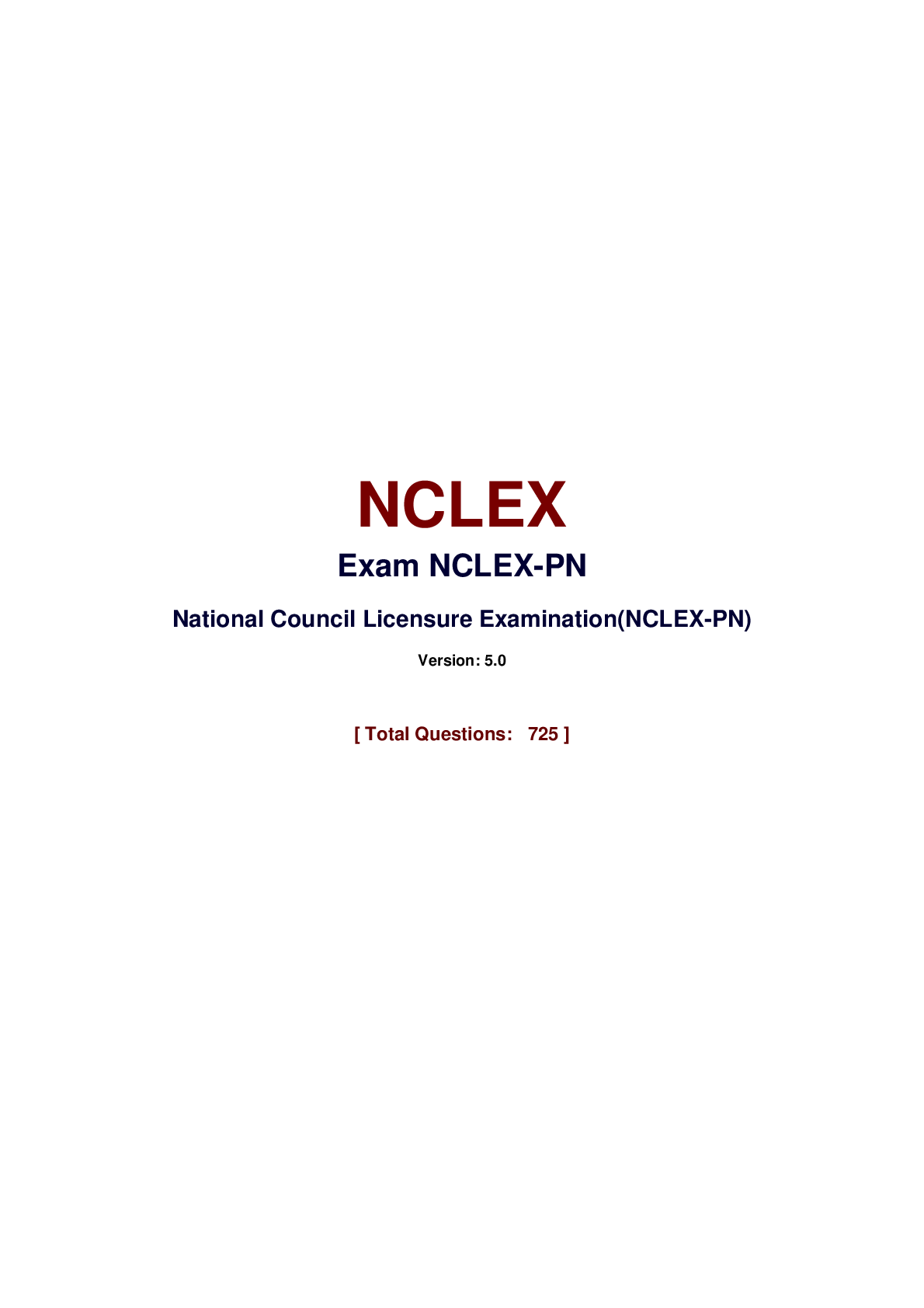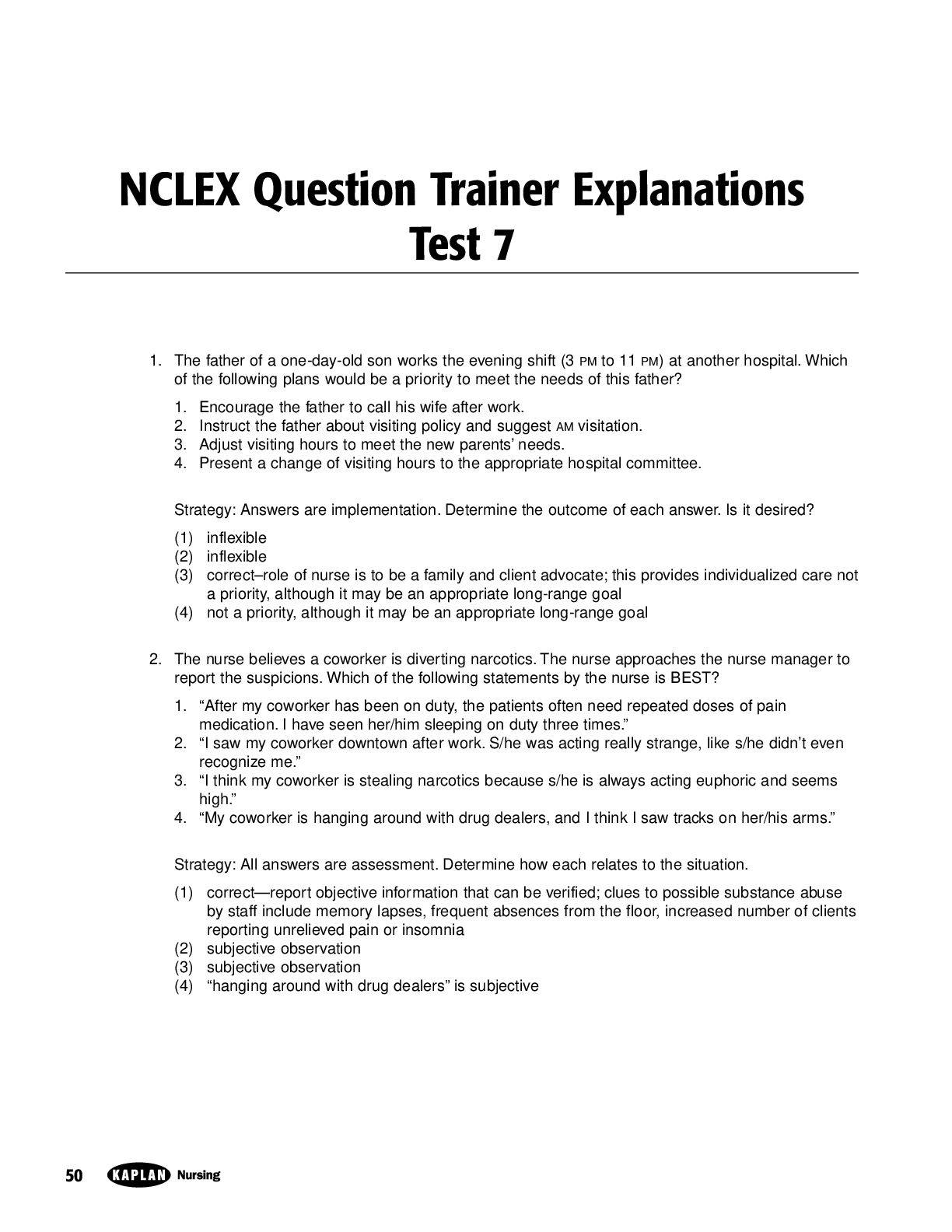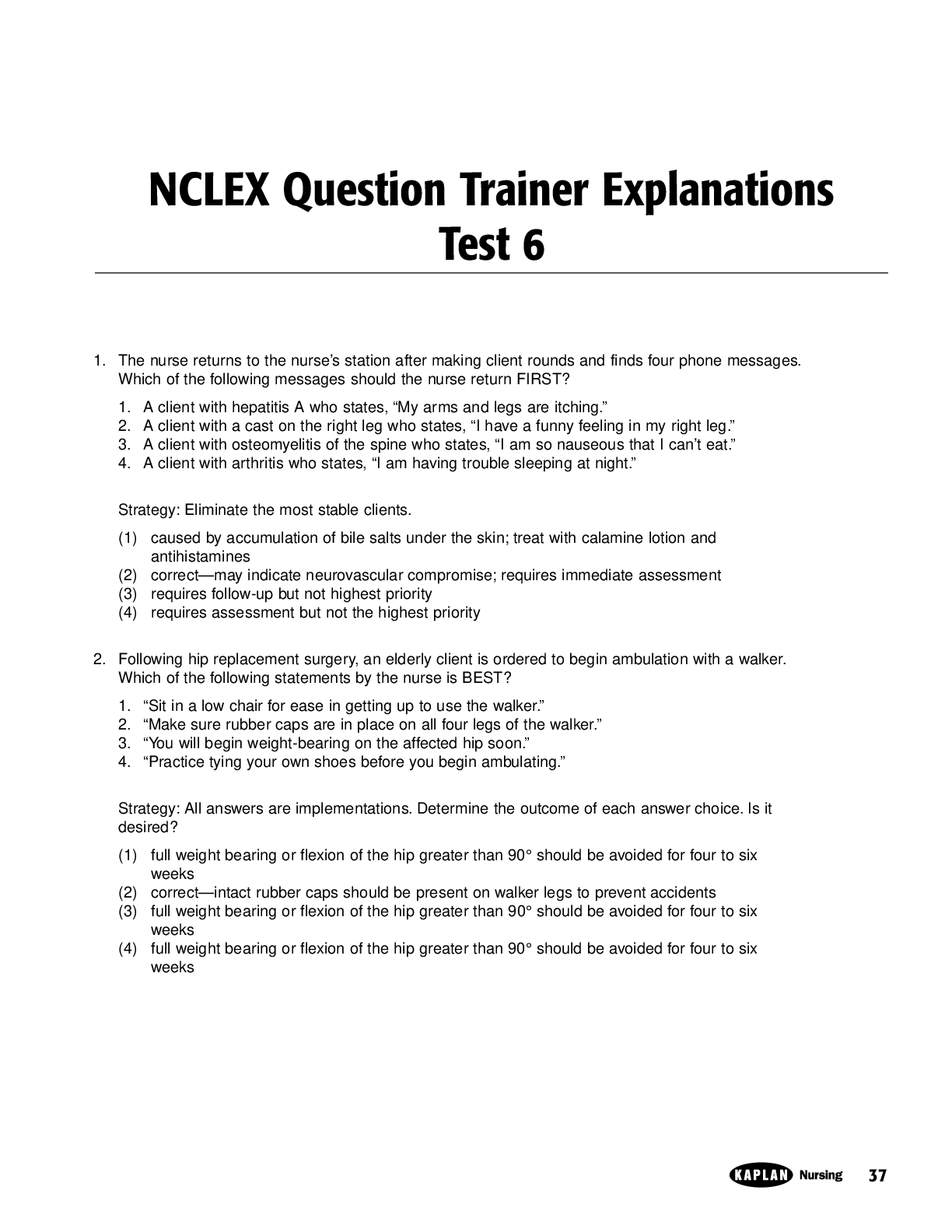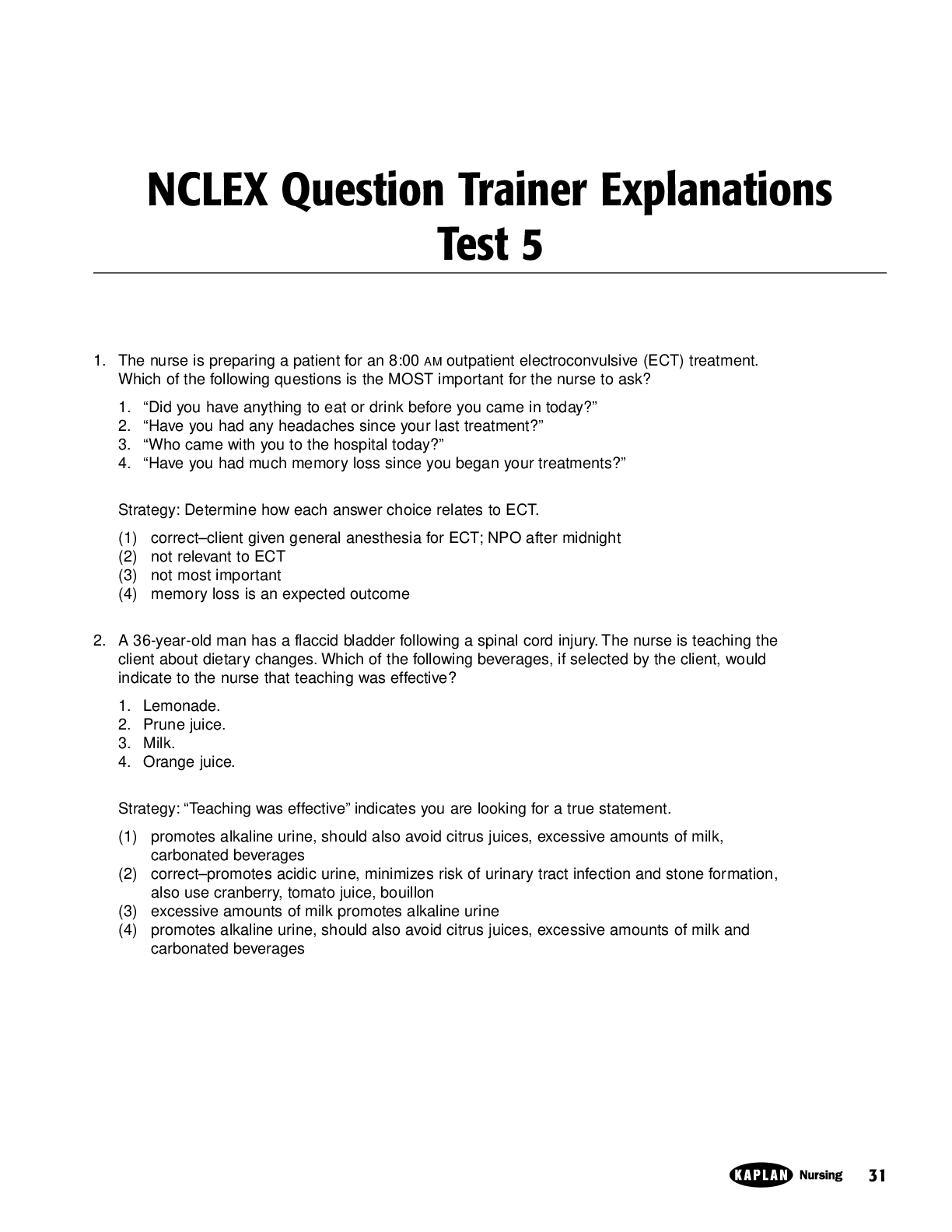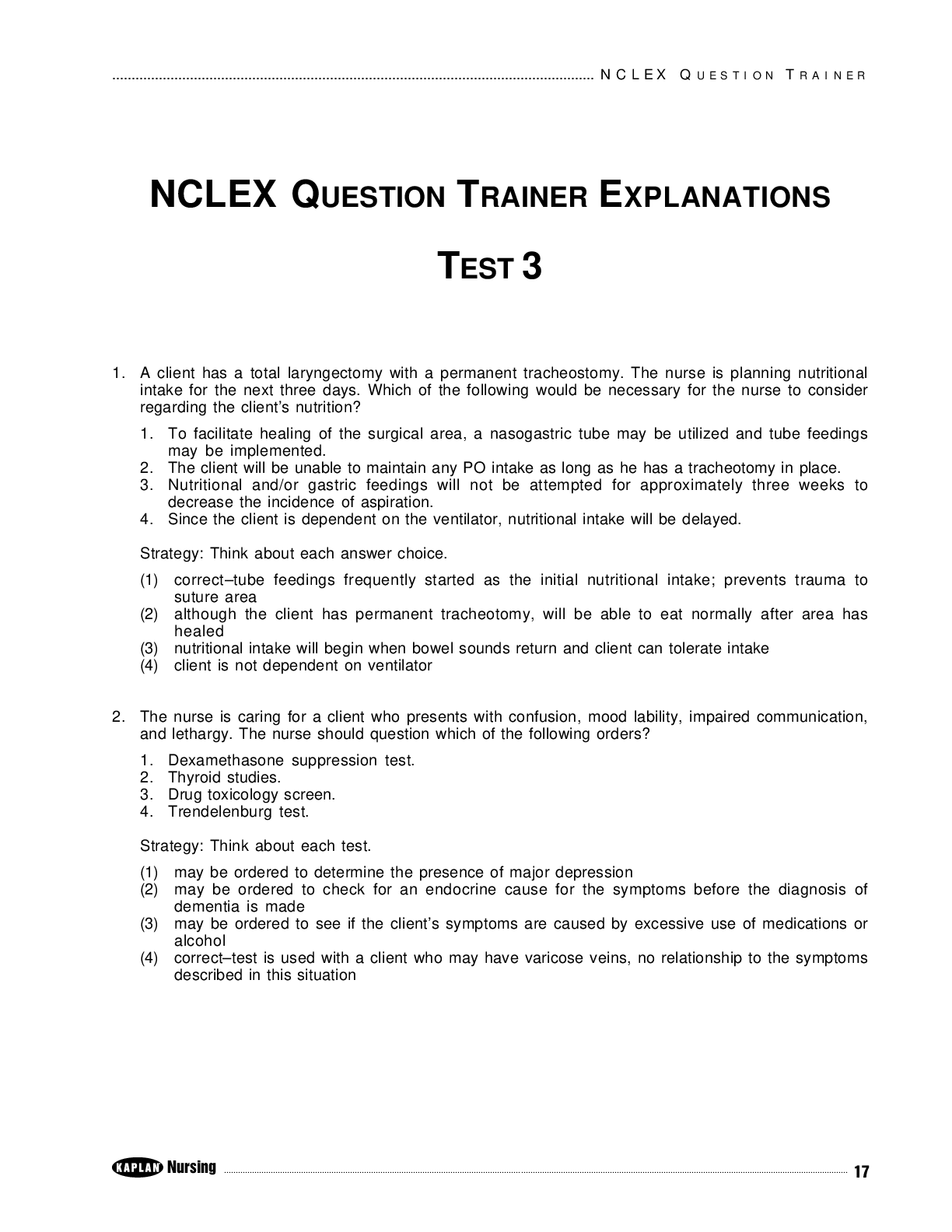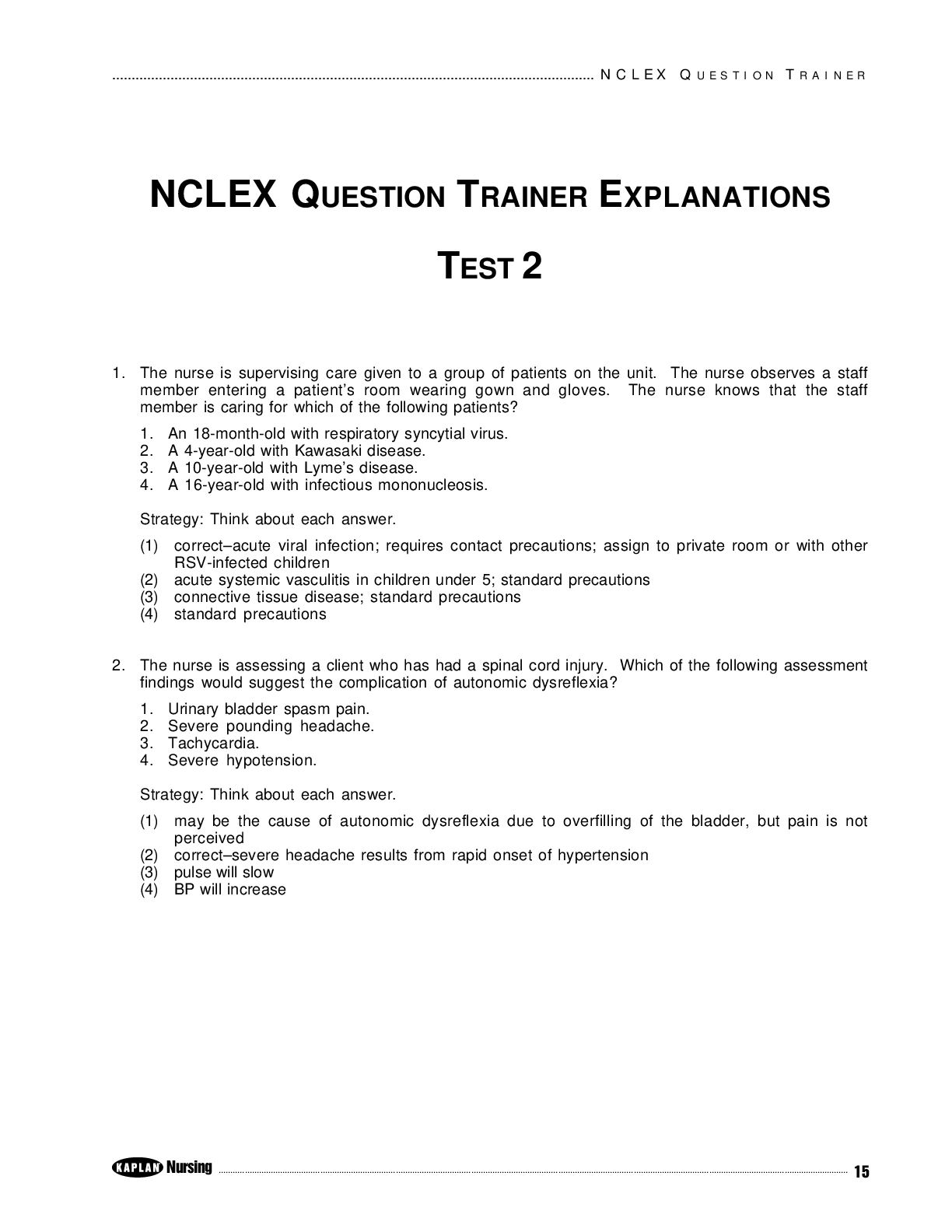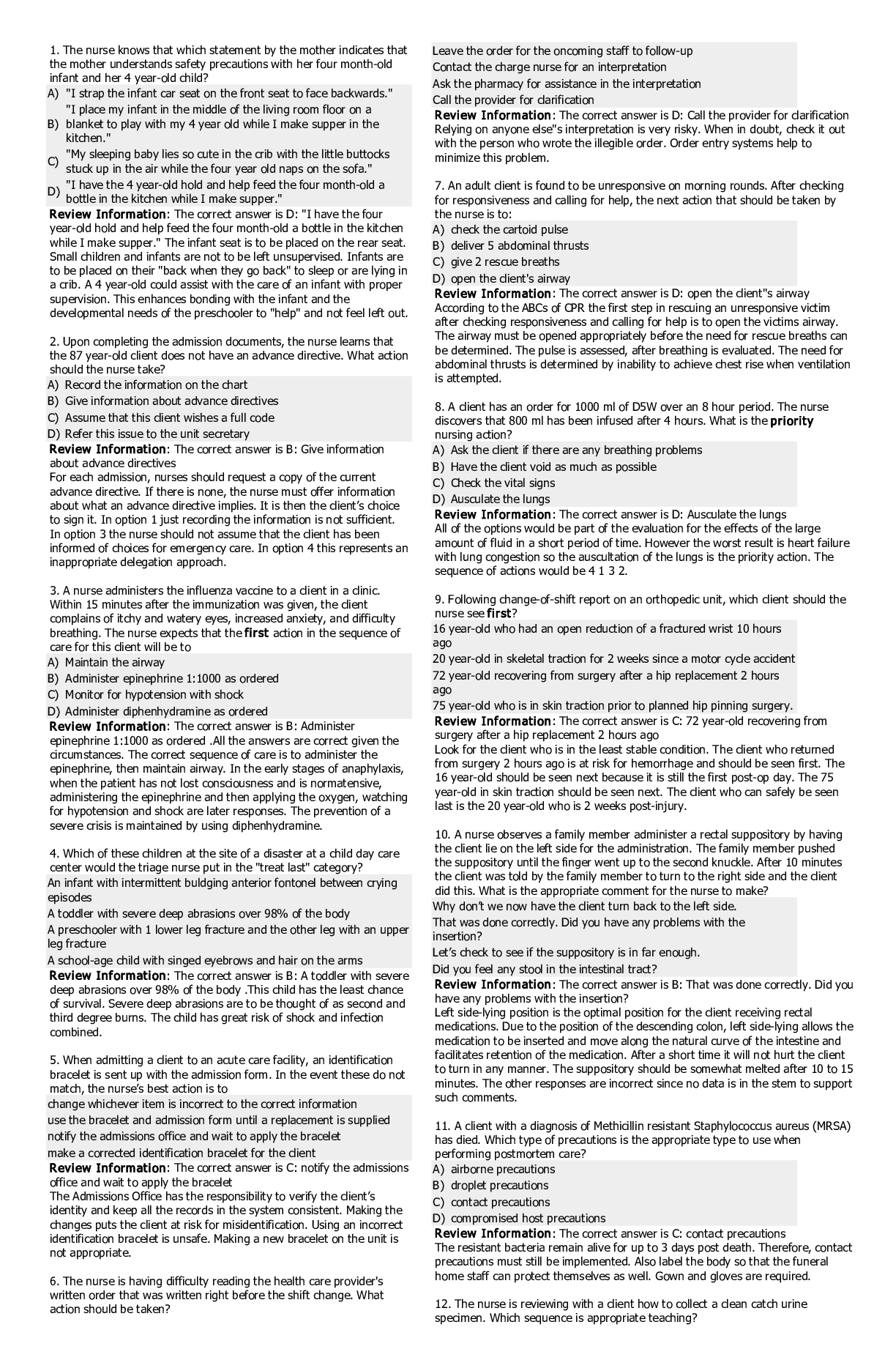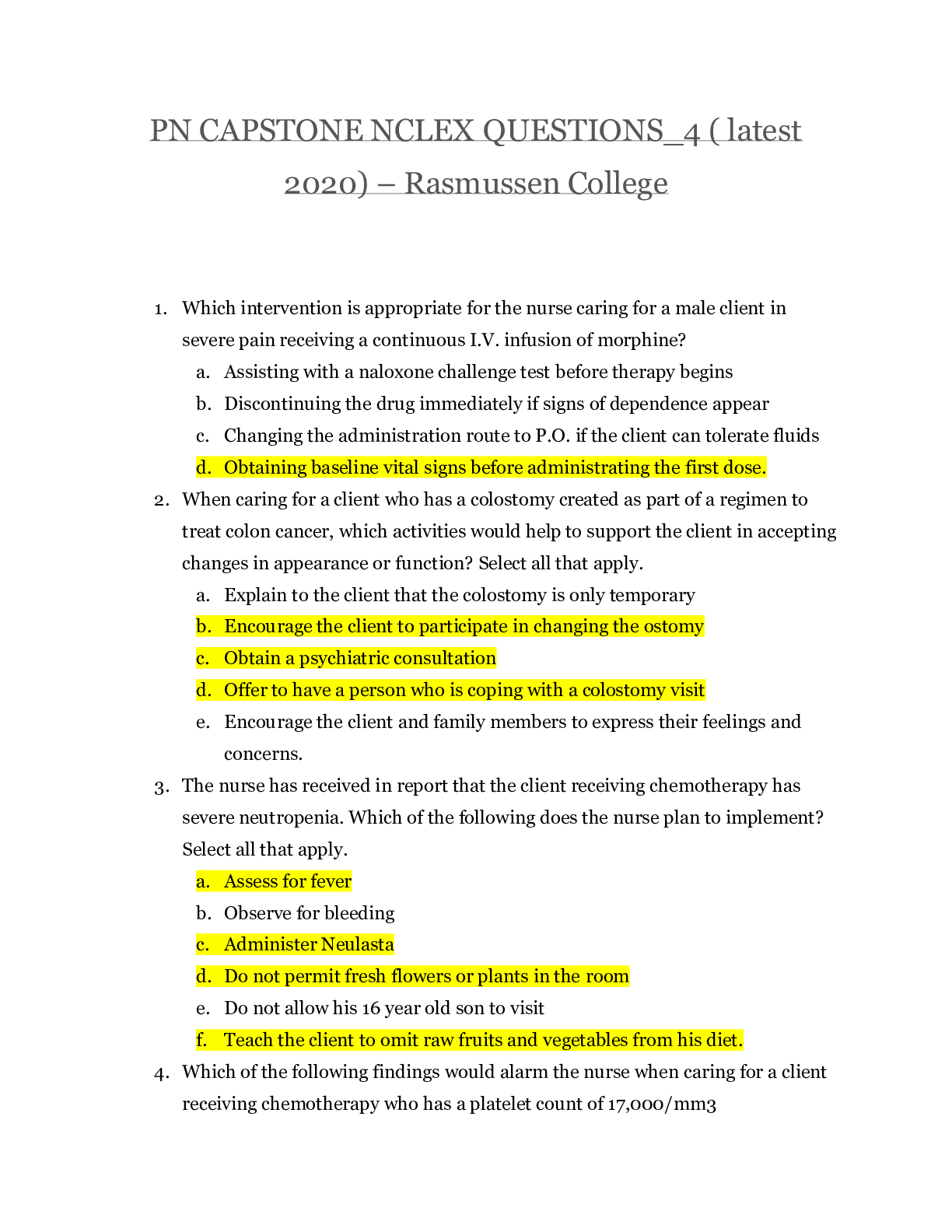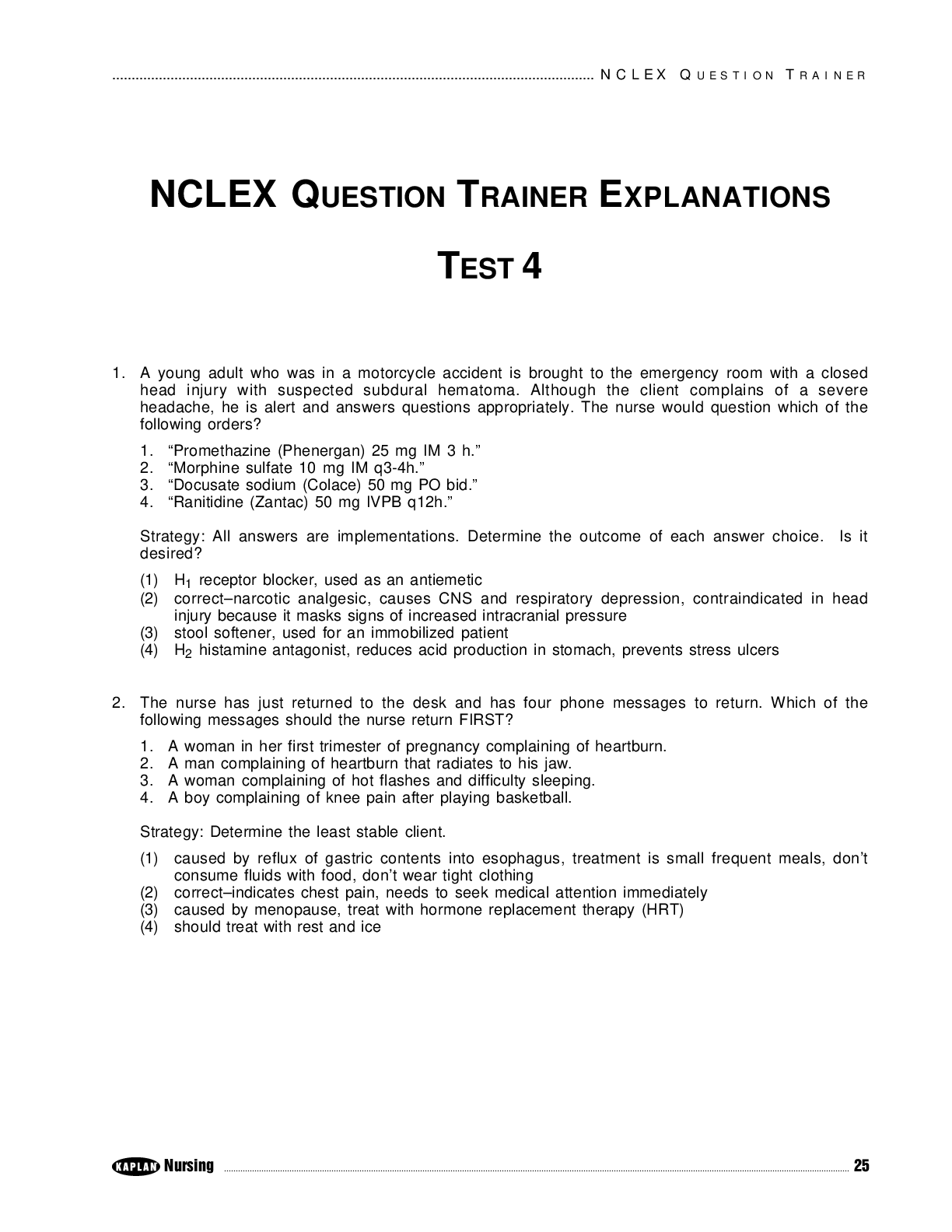Medical Studies > NCLEX-PN > NCLEX QUESTION TRAINER EXPLANATIONS TEST 4 | Med Surg 2210 NCLEX TEST 4 WITH EXPLANATIONS (All)
NCLEX QUESTION TRAINER EXPLANATIONS TEST 4 | Med Surg 2210 NCLEX TEST 4 WITH EXPLANATIONS
Document Content and Description Below
NCLEX QUESTION TRAINER EXPLANATIONS 150+ Questions and answers with explanations TEST 4 1. A young adult who was in a motorcycle accident is brought to the emergency room with a closed head injury... with suspected subdural hematoma. Although the client complains of a severe headache, he is alert and answers questions appropriately. The nurse would question which of the following orders? 1. “Promethazine (Phenergan) 25 mg IM 3 h.” 2. “Morphine sulfate 10 mg IM q3-4h.” 3. “Docusate sodium (Colace) 50 mg PO bid.” 4. “Ranitidine (Zantac) 50 mg IVPB q12h.” Strategy: All answers are implementations. Determine the outcome of each answer choice. Is it desired? (1) H1 receptor blocker, used as an antiemetic (2) correct–narcotic analgesic, causes CNS and respiratory depression, contraindicated in head injury because it masks signs of increased intracranial pressure (3) stool softener, used for an immobilized patient (4) H2 histamine antagonist, reduces acid production in stomach, prevents stress ulcers 2. The nurse has just returned to the desk and has four phone messages to return. Which of the following messages should the nurse return FIRST? 1. A woman in her first trimester of pregnancy complaining of heartburn. 2. A man complaining of heartburn that radiates to his jaw. 3. A woman complaining of hot flashes and difficulty sleeping. 4. A boy complaining of knee pain after playing basketball. Strategy: Determine the least stable client. (1) caused by reflux of gastric contents into esophagus, treatment is small frequent meals, don’t consume fluids with food, don’t wear tight clothing (2) correct–indicates chest pain, needs to seek medical attention immediately (3) caused by menopause, treat with hormone replacement therapy (HRT) (4) should treat with rest and iceP R E P A R A T I O N F O R T H E N U R S I N G L I C E N S U R E E X A M I N A T I O N ................................................ 26 ............................................................................................................................................................................................................................................................................. Nursing 3. A patient is admitted to the surgical unit with a diagnosis of rule out intestinal obstruction. The nurse is preparing to insert a Salem sump NG tube as ordered. In which of the following positions would it be BEST for the nurse to place this patient during the procedure? 1. Head of bed elevated 30°–45°. 2. Head of bed elevated 60°–90°. 3. Side-lying with head elevated 15°. 4. Lying flat with head turned to the left side. Strategy: Remember the positioning strategy. (1) not the best position (2) correct–facilitates swallowing and movement of tube through GI tract (3) not the best position (4) not the best position 4. The nurse is monitoring the fluid status of a 63-year-old woman receiving IV fluids following surgery. Which of the following symptoms would suggest to the nurse that the patient has fluid volume overload? 1. Temperature 101°F (38.3°C), BP 96/60, pulse 96 and thready. 2. Cool skin, respiratory crackles, pulse 86 and bounding. 3. Complaints of a headache, abdominal pain, and lethargy. 4. Urinary output 700 cc/24 h, CVP of 5, and nystagmus. Strategy: Determine how each answer choice relates to fluid volume overload. (1) indicates dehydration (2) correct–will see bounding pulse, elevated BP, distended neck veins, edema, headache, polyuria, diarrhea, liver enlargement (3) symptoms could be from causes other than volume overload (4) slightly reduced output, CVP would be elevated, normal CVP 4-10 mm/H2 O, involuntary eye movements not seen 5. A woman has been recently diagnosed with systemic lupus and shares with the nurse, “I am thinking about getting pregnant, but I don’t know how I will be able to tolerate a pregnancy since I have lupus.” Which of the following responses by the nurse is BEST? 1. “Most women find that they feel better when they are pregnant.” 2. “How long have you been in remission?” 3. “Women with lupus frequently have slightly longer gestations.” 4. “It is best to become pregnant within the first six months of diagnosis.” Strategy: Answers are a mix of assessments and implementations. Does this situation require assessment? Yes. (1) maternal morbidity and mortality are increased with SLE (2) correct–should be in remission for at least 5 months prior to conceiving (3) gestation not affected by SLE (4) recommended that a woman wait two years following diagnosis before conceiving............................................................................................................................ N C L E X Q U E S T I O N T R A I N E R Nursing ............................................................................................................................................................................................................................................................................ 27 6. The multidisciplinary team decides to implement behavior modification with a client. Which of the following nursing actions is of primary importance during this time? 1. Confirm that all staff members understand and comply with the treatment plan. 2. Establish mutually agreed upon, realistic goals. 3. Ensure that the potent reinforcers (rewards) are important to the client. 4. Establish a fixed interval schedule for reinforcement. Strategy: All answers are implementations. Determine the outcome of each answer choice. Is it desired? (1) correct–to implement a behavior modification plan successfully, all staff members need to be included in program development, and time must be allowed for discussion of concerns from each nursing staff member; consistency and follow-through is important to prevent or diminish the level of manipulation by the staff or client during implementation of this program (2) not of primary importance in designing an effective behavior modification program (3) not of primary importance in designing an effective behavior modification program (4) not of primary importance in designing an effective behavior modification program 7. A client received six units of regular insulin three hours ago. The nurse would be MOST concerned if which of the following was observed? 1. Kussmaul respirations and diaphoresis. 2. Anorexia and lethargy. 3. Diaphoresis and trembling. 4. Headache and polyuria. Strategy: “MOST concerned” indicates a complication. (1) Kussmaul respirations are signs of hyperglycemia (2) not indicative of hypoglycemia (3) correct–regular insulin peaks in two to four hours; indicates hypoglycemia; give skim milk (4) not indicative of hypoglycemia 8. The nursing assistant reports to the nurse that a client who is one-day postoperative after an angioplasty is refusing to eat and states, “I just don’t feel good.” Which of the following actions, if taken by the nurse, is BEST? 1. The nurse talks with the client about how he is feeling. 2. The nurse instructs the nursing assistant to sit with the client while he eats. 3. The nurse contacts the physician to obtain an order for an antacid. 4. The nurse evaluates the most recent vital signs recorded in the chart. Strategy: Answers are a mix of assessments and implementations. Does this situation require assessment? Yes. Is the assessment appropriate? Yes. (1) correct–assessment required; monitor for closure of vessel, bleeding, hypotension, dysrhythmias (2) assess cause of problem before implementing (3) assess cause of problem before implementing (4) more important to assess what is happening nowP R E P A R A T I O N F O R T H E N U R S I N G L I C E N S U R E E X A M I N A T I O N ................................................ 28 ............................................................................................................................................................................................................................................................................. Nursing 9. The nurse prepares a 25-year-old woman for a cesarean section. The patient says she had major surgery several years ago and asks if she will receive a similar “shot” before surgery. The nurse’s response should be based on an understanding that the preoperative medication given before a cesarean section 1. contains a lower overall dosage of medication than is given before general surgery. 2. contains reduced amounts of sedatives and hypnotics than are given before general surgery. 3. contains reduced amounts of narcotics than are given before general surgery. 4. contains medications similar in type and dosages to those given before general surgery. Strategy: Think about the action of the medications. (1) decreased dosage of narcotics are used (2) dosages of sedatives and hypnotics will be similar (3) correct–decreased so less narcotic crosses the placental barrier causing respiratory depression in the infant (4) dosages of narcotics are reduced 10. The nurse is caring for an 11-year-old patient being treated for a fractured right femur with balanced suspension traction with a Thomas splint and Pearson attachment. The nurse notes that the patient’s left leg is externally rotated. The nurse should 1. place a trochanter roll on the outer aspect of the thigh. 2. perform resistive range of motion of the left leg. 3. adduct and internally rotate the left leg. 4. instruct the patient to maintain the left leg in a neutral position. Strategy: Answers are implementations. Determine the outcome of each answer choice. Is it desired? (1) correct–holds hip in neutral position and leg in normal alignment, entire weight of leg cannot be held by props placed below knee (2) exercise would not prevent future external rotation of the leg (3) adduct (add to midline of body) does not change external rotation, internal rotation is not beneficial, normal alignment is required (4) leg will externally rotate unless propped in proper alignment 11. The nurse is preparing a five-year-old child for surgery. The nurse notes that the child’s parents are divorced and have joint legal custody. The informed consent for surgery has been signed by the mother. Which of the following actions by the nurse is BEST? 1. Notify the physician. 2. Inform surgery. 3. Contact the father to obtain consent. 4. Continue the child’s preoperative preparation. Strategy: All answers are implementations. Determine the outcome of each answer choice. Is it desired? (1) no reason to notify the physician (2) no reason to call the OR (3) consent from either divorced parent is sufficient (4) correct–parent or legal guardian required to give informed consent prior to surgical procedure............................................................................................................................ N C L E X Q U E S T I O N T R A I N E R Nursing ............................................................................................................................................................................................................................................................................ 29 12. The nurse is caring for clients on the neurology unit. What would be the MOST appropriate action for the nurse to take after noting that a client suddenly developed a fixed and dilated pupil? 1. Reassess in five minutes. 2. Check the client’s visual acuity. 3. Lower the head of the client’s bed. 4. Contact the physician. Strategy: Answers are a mix of assessments and implementations. Is this a situation that requires assessment or validation? No. Determine the outcome of the implementations. (1) assessment, situation does not require validation (2) assessment, has symptoms of increased ICP (3) implementation, would increase the intracranial pressure (4) correct–implementation, fixed and dilated pupil represents a neurological emergency 13. A mother brings her two-year-old boy to the pediatrician’s office. Which of the following symptoms would suggest to the nurse that the child has strabismus? 1. When the child draws, he places his head close to the table. 2. The child rubs his eyes frequently. 3. The child closes one eye to see a poster on the wall. 4. The child is unable to see objects in the periphery of his visual field. Strategy: Think about each answer choice. (1) suggestive of refractive error, myopia (nearsightedness), able to see objects at close range (2) suggestive of refractive error (3) correct–visual axes are not parallel so the brain receives two images (4) suggestive of cataracts or problem with peripheral vision 14. A client is given morphine 6 mg IV push for postoperative pain. Following administration of this drug, the nurse observes the following: pulse 68, respirations 8, BP 100/68, client sleeping quietly. Which of the following nursing actions is MOST appropriate? 1. Allow the client to sleep undisturbed. 2. Administer oxygen via facemask or nasal prongs. 3. Administer naloxone (Narcan). 4. Place epinephrine 1:1,000 at the bedside. Strategy: All answers are implementations. Determine the outcome of each answer choice. Is it desired? (1) should be given Narcan for low respiratory rate (2) problem is low respirations, this may be administered after medication (3) correct–IV naloxone (Narcan) should be given to reverse respiratory depression; respiratory rate of 8 is too low and necessitates a nursing action (4) unnecessaryP R E P A R A T I O N F O R T H E N U R S I N G L I C E N S U R E E X A M I N A T I O N ................................................ 30 ............................................................................................................................................................................................................................................................................. Nursing 15. The school nurse is teaching a group of preschool mothers about poison prevention in the home. Which of the following statements, if made by a mother to the nurse, indicates that further teaching is necessary? 1. “I should have a bottle of Ipecac for each of my children.” 2. “I should induce vomiting if my child swallows lighter fluid.” 3. “Giving my child water or milk may help dilute the poison.” 4. “Proper storage is the key to poison prevention in the home.” Strategy: “Further teaching is necessary” indicates an incorrect statement. (1) Ipecac is available in 30 cc vials, advise parents to have available full doses for each child, doses range from 10 to 30 cc (2) correct–vomiting contraindicated when child ingests hydrocarbons due to danger of aspiration (3) small amounts of water or milk may dilute toxins (4) store in locked cabinets 16. The nurse is caring for a manic client in the seclusion room, and it is time for lunch. It is MOST appropriate for the nurse to take which of the following actions? 1. Take the client to the dining room with 1:1 supervision. 2. Inform the client he may go to the dining room when he controls his behavior. 3. Hold the meal until the client is able to come out of seclusion. 4. Serve the meal to the client in the seclusion room. Strategy: All answers are implementations. Determine the outcome of each answer choice. Is it desired? (1) should remain in the seclusion room (2) should have meal at regular time (3) should have meal at regular time (4) correct–should eat at regular time; remain in the seclusion room for client’s safety - - - - - - - - - - - - - - - - - - - - - - - - - - - - - - - 140. To maintain client safety, the nurse should have which of the following equipment readily available when inserting an Ewald tube? 1. Suction equipment. 2. Blood pressure cuff. 3. Levine tube. 4. Emesis basin. Strategy: Think about each answer choice. (1) correct–Ewald tube is a large orogastric tube designed for rapid lavage; insertion often causes gagging and vomiting, suction equipment must be immediately available to reduce the risk of aspiration (2) not a high priority (3) not a high priority (4) not a high priorityP R E P A R A T I O N F O R T H E N U R S I N G L I C E N S U R E E X A M I N A T I O N ................................................ 72 ............................................................................................................................................................................................................................................................................. Nursing 141. In planning anticipatory guidance for parents of a beginning school-aged child, it is MOST important for the nurse to include which of the following? 1. Teach the child to read and write. 2. Teach the child sex education at home. 3. Give the child responsibility around the house. 4. Expect stormy behavior. Strategy: Answers are implementations. Determine the outcome of each answer choice. Is it desired? (1) may require some assistance from the parents, but children this age learn at their own rate (2) unnecessary at this early age (3) correct–giving children responsibilities allows them to develop feelings of competence and selfesteem through their industry (4) does not occur until about age 11 142. The nurse is caring for clients in the antepartal clinic. A client at 34-weeks gestation comes to the clinic for treatment of a sprained ankle. The nurse should question which of the following orders? 1. ASA (aspirin) 650 mg PO q4h PRN for pain. 2. Return to the clinic in two weeks. 3. Ice to sprain for 20 minutes qh for 24h. 4. Teach client 3-gait crutch walking. Strategy: Determine the outcome of each answer choice. Is it desired? (1) correct–aspirin can cause fetal hemorrhage, do not use during pregnancy (2) routine follow-up (3) treat sprain with rest and elevation of affected part; intermittent ice compresses for 24 hours (4) appropriate gait if client unable to bear weight 143. Which of the following nursing actions would be important for safe administration of oxytocin? 1. Assess respirations and urine output. 2. Administer oxytocin parenterally as the primary IV. 3. Have calcium gluconate available as an antidote. 4. Palpate the uterus frequently. Strategy: Answers are a mix of assessments and implementations. Is there an appropriate assessment? Yes. (1) assessment, pertinent to the care of a client receiving magnesium sulfate for preeclampsia (2) implementation, oxytocin is always given via an infusion pump and is never allowed to be the primary IV (3) implementation, pertinent to the care of a client receiving magnesium sulfate for preeclampsia (4) correct–assessment, oxytocin stimulates the uterus to contract, which necessitates frequent assessment of the uterus; prolonged tetanic contraction can lead to a ruptured uterus............................................................................................................................ N C L E X Q U E S T I O N T R A I N E R Nursing ............................................................................................................................................................................................................................................................................ 73 144. An adult client has regular insulin ordered before breakfast. The nurse notes that the client’s blood glucose level is 68 mg/dL, and the client is nauseated. Which of the following actions should the nurse take? 1. Immediately give the client orange juice to drink. 2. Administer the insulin on time. 3. Withhold the insulin and notify the physician. 4. Return the breakfast tray to the kitchen. Strategy: All answers are implementations. Determine the outcome of each answer choice. Is it desired? (1) may cause vomiting (2) correct–take insulin or oral agent as ordered, check blood glucose or urine ketones every 3-4 hours, sip 8-12 oz liquid per hour, substitute easily digested soft foods, liquids if solids not tolerated (3) blood glucose increases during illness even though client can’t eat, administer insulin (4) does not address the client’s problem 145. The nurse is caring for client in the Emergency Department of an acute care facility. Four clients have been admitted in the last 10 minutes. Which of the following admissions should the nurse see FIRST? 1. A client complaining of chest pain that is unrelieved by nitroglycerine. 2. A client with third-degree burns to the face. 3. A client with a fractured hip. 4. A client complaining of epigastric pain. Strategy: Think ABCs. (1) not the highest priority; airway most important (2) correct–face, neck, chest, or abdominal burns result in severe edema, causing airway restriction (3) airway is most important (4) requires further assessment, airway is a priority 146. The nurse is preparing to perform peritoneal dialysis on a 65-year-old patient. The patient states she had pain the last time the procedure was done. It would be MOST appropriate for the nurse to take which of the following actions? 1. Administer a warm drink to the patient. 2. Administer a warm bath to the patient. 3. Warm the bag of dialysate solution with a heating pad. 4. Warm the bag of dialysate solution in a microwave oven. Strategy: All answers are implementations. Determine the outcome of each answer choice. Is it desired? (1) does not affect pain with fluid infusion (2) does not affect pain with fluid infusion (3) correct–temperature can be regulated, warming reduces pain caused by cold solution (4) contraindicated because of unpredictable warming patternsP R E P A R A T I O N F O R T H E N U R S I N G L I C E N S U R E E X A M I N A T I O N ................................................ 74 ............................................................................................................................................................................................................................................................................. Nursing 147. Which of the following symptoms are MOST likely to be observed by the nurse when a client is withdrawing from heroin? 1. Severe cravings, depression, fatigue, hypersomnia. 2. Depression, disturbed sleep, restlessness, disorientation. 3. Nausea and vomiting, tachycardia, coarse tremors, seizures. 4. Runny nose, yawning, fever, muscle and joint pain, diarrhea. Strategy: Think about the cause of each symptom and how it relates to narcotic withdrawal. (1) describes cocaine withdrawal (2) describes amphetamine withdrawal (3) describes barbiturate withdrawal (4) correct–narcotic withdrawal is very much like the symptoms of the flu 148. The nurse is caring for a 26-year-old woman immediately after delivery of an 8 lb 4 oz baby girl. The patient’s history indicates she was diagnosed with type I diabetes mellitus (IDDM) at age 12. The nurse would expect which of the following changes to occur in the patient? 1. The blood sugar will fall due to a sudden decrease in insulin requirements. 2. The blood sugar will rise due to a rapid decrease in circulating insulin. 3. The blood sugar will gradually rise due to a decreased level of metabolic stress. 4. The blood sugar will gradually fall due to a decrease in food intake. Strategy: Think about each answer choice. (1) correct–hormonal interference in glucose metabolism during pregnancy causes insulin requirements to increase then decrease after delivery (2) blood sugar will fall after delivery (3) blood sugar level will fall after delivery (4) fall in blood sugar not primarily caused by decrease in food intake 149. In caring for a client with a nursing diagnosis of rape trauma syndrome, acute phase, the nurse should consider the MOST important initial goal to be that 1. within three to five months, the client will state that the memory of the event is less vivid and distressing. 2. the client will indicate a willingness to keep a follow-up appointment with a rape crisis counselor. 3. the client will be able to describe the results of the physical examination that was completed in the emergency room. 4. the client will begin to express her reactions and feelings about the assault before leaving the emergency room. Strategy: Think about each answer choice. (1) valid goal that needs to be addressed, but after the initial goal has been met (2) valid goal that needs to be addressed, but after the initial goal has been met (3) valid goal that needs to be addressed, but after the initial goal has been met (4) correct–is nurse’s initial priority to encourage client to begin dealing with what happened by verbalizing her feelings and gaining some acceptance and perspective............................................................................................................................ N C L E X Q U E S T I O N T R A I N E R Nursing ............................................................................................................................................................................................................................................................................ 75 150. The nurse is leading an in-service education class on legal issues. Which of the following acts constitutes battery? 1. The nurse restrains an agitated, confused patient in the Emergency Room with a physician’s order. 2. The nurse chases a patient who tries to run away while outside for a walk. 3. The nurse holds the arms of a manic patient who struck her while calling for assistance. 4. The nurse administers an injection to a schizophrenic patient who refuses to take the medication by mouth because he believes it is poison. Strategy: Determine the outcome of each answer choice. (1) restraining a client to prevent injury to self or others is appropriate (2) appropriate behavior (3) restraining a client to prevent injury to self or others is appropriate (4) correct–battery is harmful or offensive touching of another’s person; unless court ordered, clients have the right to refuse medication, even if client is psychotic [Show More]
Last updated: 1 year ago
Preview 1 out of 51 pages
Instant download
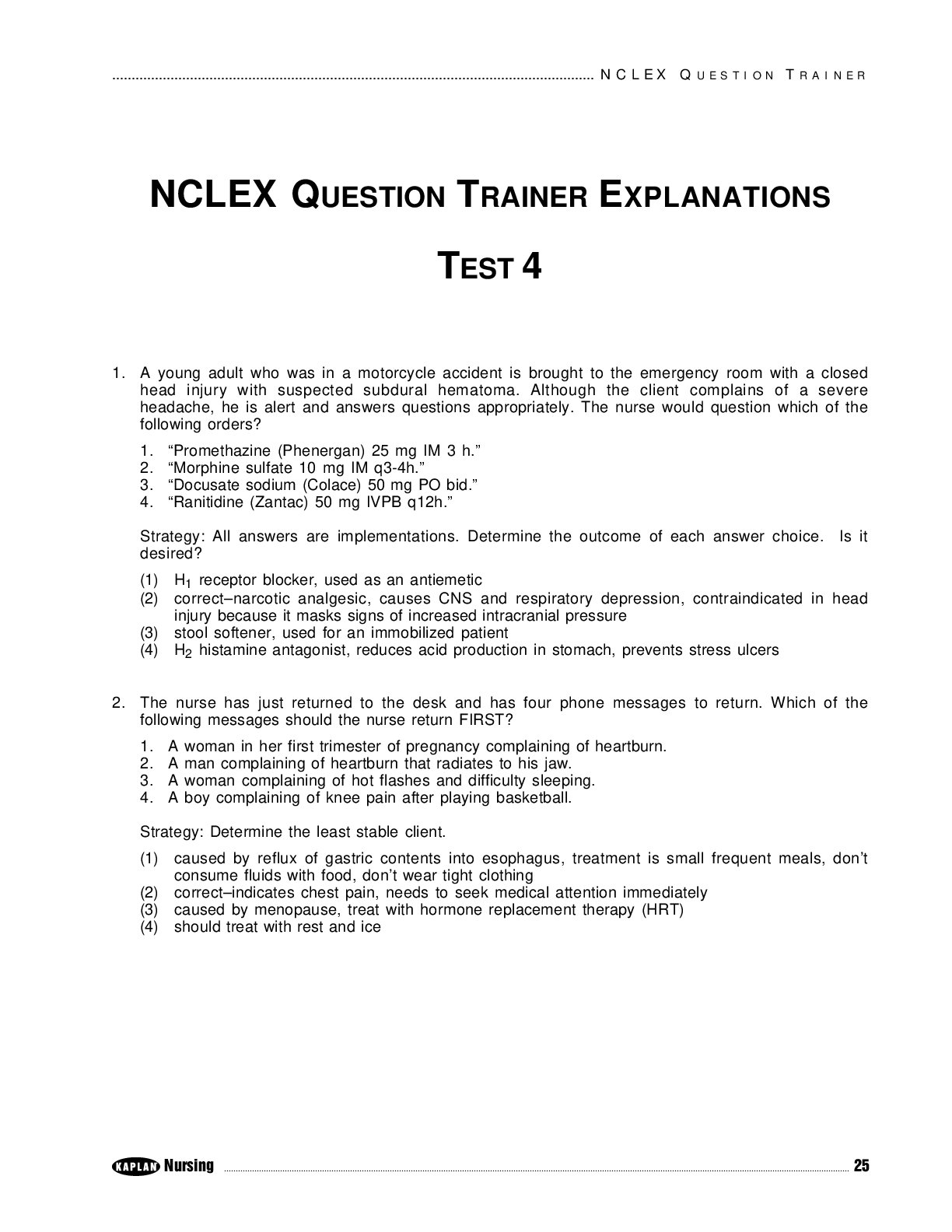
Buy this document to get the full access instantly
Instant Download Access after purchase
Add to cartInstant download
Reviews( 0 )
Document information
Connected school, study & course
About the document
Uploaded On
Aug 04, 2020
Number of pages
51
Written in
Additional information
This document has been written for:
Uploaded
Aug 04, 2020
Downloads
0
Views
122

